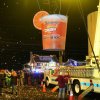Wines from Sicily go well with all sorts of food
How many remember Lamoresca? In last week’s mail, Sophie asked why I haven’t reviewed any wines from Sicily. As one who enjoys artichokes (carciofi all Sicilia), cannoli, caponata, cappelletti en brodo, cassata, eggplant parm, granita (slushy, so fine and thick it is eaten with a spoon, but not a sorbet), olives of every cure and stunning olive oil so good that the Godfather founded Genco, I have been remiss indeed.
Brief side note regarding olive oil, a very complex subject. Locating real Sicilian XVOO is very difficult. The regulations are specious and the island is still controlled by “the black hand” and Corsican banditos. Many EVOO are pressed from olives grown in Greece, Spain, Turkey, Tunisia, etc. where “lampante,” olives harvested from the ground, are gathered and hot pressed, then oil is shipped in bulk and bottled in the stated country of origin, possibly blended with local oil or not. True EVOO Sicilian must employ olives picked at the designated location, be cold pressed and show no more than 1% acidity. Some names to look for are Agrestis or Cutrera PDO Monti Iblei, Tenuta Baronale and Titone PDO Trapanesi Organic.
Sicily is a McFood paradiso. Those who have enjoyed the traditional almond pastry, an amuse bouche dessert, with a small glass of Malvasia, will definitely be hooked. Curious winos and foodies may wish to peruse some Roberta Gangi, who is an expert on the Med, its food, wine and tourist spots. Hauner Malvasia delle Lipari Passito DOC 2017 is my choice with the almond pastry, 93 McD, $40/375 ml. Dark honey-golden, opens to dried fruit, fresh apricot, honey and pie spice. Huge, round mouthfeel, its sweetness is perfectly offset by the acidity. The bouquet repeats as flavors and lingers through a long, clean finish.
Back to the Lamoresca Nerocapitano Rosso. The 2015, ‘17 and ‘19 all garnered 94 McD and can be found under $40. Filippo Rizzo left his Belgium restaurant and returned to the family farm in the vicinity of Catania with wife Nancy. His idea was to produce wine with low intervention. He uses no chemicals or pesticides. The wine is naturally fermented without temperature control and no sulfur is used. Nerocapitano is the grape locals call Frappato. It is known for its high terpine, norisprenoid and benzenoid content, which provide intense aromas. Look for red cherries, dark chocolate, pomegranate and a soft mouthfeel. Lovely balance. A top-flight example of Frappato. Normally blended with Nero d’ Avola to boost body and color.
While researching Sicily, I learned these factoids. The Map of Roger (Tabula Rogeriana) and Book of Roger (Kitab Rujar) is considered one of the most important scientific studies of the Middle Ages. Written by Abu Abdullah ibn Muhammad ibn Abdallah ibn Edrisi, a court chronicler, cartographer and explorer, commissioned by the Norman King Roger ll in Palermo, Sicily, 1138, about one century before Marco Polo was born, it was completed and illustrated by 1154. He wrote, ”In the Sicilian town of Trabia, the inhabitants made a form of pasta from hard wheat” and that, “this product, shaped into long strands, was manufactured in large quantity for export to other regions.” This is notable because there is no other known reference to spaghetti or formed pasta in the dietary works of Europe from that era. Idris also wrote, “The earth is round like a sphere.” He calculated the circumference at 37,000 kilometers, > 10% error. The map was inscribed on a 300-lb. silver disc and was accompanied by the encyclopedic book. Both originals were destroyed, but there is much corroborative writing describing them. El Idrisi, one of few historical figures known by one name, reproduced a truncated copy written for Roger’s son William ll which still exists in its original form, and there are dated authenticated copies in highly regarded repositories. Although he was embraced by Jews, Muslims and the Eastern Orthodoxies, the Medieval popes, who were still pushing Copernican Theory and its attendant corollaries, suppressed the work in Europe. Pull a cork, grab a glass and go here for more detail: cartographyunchained.com/cgid3/ and find a copy here: issuu.com/376746/docs/219-al-idrisi.



















































